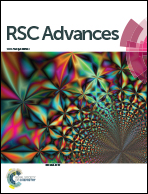Carbon dots isolated from chromatographic fractions for sensing applications†
Abstract
A fast and easy approach to synthesise carbon dots (C-dots) by simply mixing acetic acid, N-acetyl-L-cysteine (NAC), water, and diphosphorus pentoxide has been developed. The synthesised C-dots sample has been found to be a relatively complex mixture, and its complexity can be reduced significantly by high-performance liquid chromatography (HPLC). The separated C-dots fractions are collected and characterised by UV-vis absorption spectroscopy, photoluminescence (PL) spectroscopy, matrix-assisted laser desorption/ionisation time-of-flight mass spectrometry (MALDI-TOF MS), and transmission electron microscopy. The C-dots fractions display unique absorption bands and specific emission wavelengths which are fully anatomised by MALDI-TOF MS, displaying their fragmentation mass ion features. The core sizes of some selected C-dots are 2.51, 2.83, 2.90, 3.17, 3.39, and 3.44 nm, consistent with their HPLC elution order. The fractionated C-dots show profound differences in emission quantum yield, allowing the brighter C-dots to be isolated from an apparent low quantum yield mixture. These brighter C-dots fractions can be used as fluorescent probes for sensitive detection of Fe3+ and Hg2+.


 Please wait while we load your content...
Please wait while we load your content...